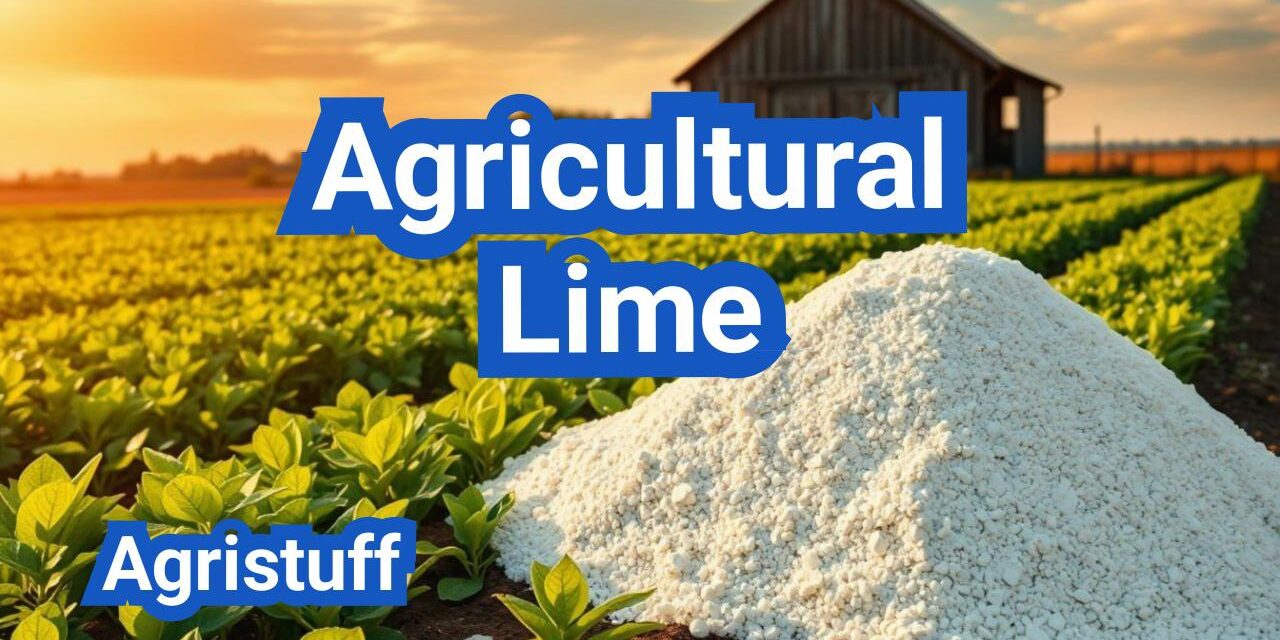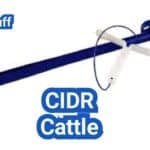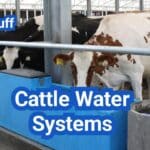Maintaining optimal soil pH is crucial for crop health and productivity of the agricultural land. The ideal soil pH level is slightly acidic to neutral, ranging between 5.8 and 7.0. When soil becomes too acidic, it can hinder nutrient availability, affecting crop growth.
A soil additive like lime can help increase the soil pH, making nutrients more accessible to crops. By applying lime, farmers can improve soil fertility and promote healthy crop development.
The importance of using agricultural lime lies in its ability to enhance soil conditions, leading to better crop yields. Understanding when and how to apply lime is vital for maximizing its benefits.
Key Takeaways
- Optimal soil pH is between 5.8 and 7.0 for most crops.
- Soil additives like lime can adjust pH levels.
- Agricultural lime improves nutrient availability.
- Proper application timing is crucial for effectiveness.
- Understanding soil conditions is key to using lime effectively.
Understanding Agricultural Lime and Its Purpose
To understand the importance of agricultural lime, it’s essential to know its composition and how it works. Agricultural lime is a soil amendment made from ground limestone rock, which naturally contains calcium carbonate and magnesium carbonate.
Definition and Basic Composition
Agricultural lime is primarily composed of calcium carbonate (CaCO3), with some forms also containing magnesium carbonate (MgCO3). The presence of these compounds helps to neutralize soil acidity.
The effectiveness of agricultural lime is determined by its Effective Calcium Carbonate Equivalent (ECCE), which measures its neutralizing power relative to pure calcium carbonate. Another critical factor is the lime fineness mesh size, as finer particles react more quickly with the soil.
Agricultural Limestone vs. Other Soil Amendments
Agricultural limestone is often compared to other soil amendments like dolomitic lime and calcitic lime. Dolomitic lime contains both calcium and magnesium carbonate, while calcitic lime is primarily calcium carbonate. The choice between these depends on the soil’s nutrient deficiencies and pH levels.
| Type of Lime | Primary Composition | Benefits |
|---|---|---|
| Calcitic Lime | Calcium Carbonate (CaCO3) | Corrects soil acidity, provides calcium |
| Dolomitic Lime | Calcium-Magnesium Carbonate (CaMg(CO3)2) | Corrects soil acidity, provides both calcium and magnesium |
How Lime Neutralizes Soil Acidity
Lime works by reacting with hydrogen ions in the soil, which are responsible for acidity. The calcium and magnesium in lime replace hydrogen ions, thereby increasing the soil’s pH and making it less acidic.
This process not only improves soil pH but also enhances nutrient availability for plants, promoting healthier growth.
The Science Behind Soil Acidity and Liming
Soil pH is a fundamental aspect of soil health that influences the overall fertility and productivity of the land. It affects the availability of nutrients for crops, microbial activity, and the overall soil ecosystem.
What Causes Soil to Become Acidic
Soil becomes acidic due to various factors, including heavy rainfall, excessive use of nitrogen fertilizers, and the decomposition of organic matter. High rainfall areas tend to have more acidic soils because rainwater leaches away basic cations, leaving behind acidic components.
The use of certain fertilizers can also contribute to soil acidity. For instance, ammonium-based fertilizers release hydrogen ions as they are converted into nitrate, thereby lowering the soil pH.
The pH Scale and Soil Health
The pH scale ranges from 0 to 14, with 7 being neutral. Most crops prefer a slightly acidic to neutral soil pH, between 6.0 and 7.0. Soil pH outside this range can lead to nutrient deficiencies and reduced crop yields.
Understanding the pH scale is crucial for managing soil health. It helps farmers determine the appropriate lime application rates to adjust the soil pH to optimal levels for their crops.
How Lime Affects Nutrient Availability
Lime application can significantly impact nutrient availability in soils. By raising the soil pH, lime makes nutrients more accessible to plants. For example, calcium and magnesium in lime are essential nutrients for plant growth.
Liming also enhances the availability of phosphorus, a critical nutrient for plant development. In acidic soils, phosphorus is often bound to aluminum and iron oxides, making it unavailable to crops.
Biological Benefits of Proper pH
Maintaining the proper soil pH has numerous biological benefits. It promotes healthy microbial activity, which is vital for nutrient cycling and soil structure. Beneficial microorganisms thrive in soils with optimal pH, contributing to a more resilient and productive agricultural system.
A balanced soil pH also supports the overall biodiversity of the soil ecosystem, ensuring that crops have the best possible conditions to grow.
Types of Agricultural Lime Available in the U.S.
Understanding the different types of agricultural lime available is crucial for effective soil management in U.S. agriculture. The choice of lime product can significantly impact soil health, crop yield, and overall farm profitability.
Calcitic Lime (High Calcium)
Calcitic lime, also known as high-calcium lime, is primarily composed of calcium carbonate (CaCO3). It is the most common type of agricultural lime used in the U.S., particularly in regions where soils are derived from granite or other calcium-poor parent materials.
- High calcium content
- Effective at neutralizing soil acidity
- May not provide sufficient magnesium for soils with magnesium deficiencies
Dolomitic Lime (Calcium-Magnesium)
Dolomitic lime contains both calcium carbonate and magnesium carbonate (CaMg(CO3)2). It is particularly beneficial for soils that are deficient in magnesium, as it provides both calcium and magnesium to the soil.
Key benefits of dolomitic lime:
- Provides both calcium and magnesium
- Can improve soil structure
- Beneficial for crops with high magnesium requirements
Pelletized Lime vs. Traditional Aglime
The form in which lime is applied can affect its efficacy and ease of use. Pelletized lime is a more modern form of lime that has been processed into uniform pellets. This form offers several advantages over traditional aglime, including easier handling and more uniform application.
| Characteristics | Pelletized Lime | Traditional Aglime |
|---|---|---|
| Application Ease | Easier to spread uniformly | Can be more difficult to spread evenly |
| Handling | Less dusty, easier to handle | Can be dusty and more challenging to handle |
Liquid and Suspension Lime Products
Liquid lime products are another option available to farmers. These products are typically suspensions of fine lime particles in water. They offer the advantage of being able to be applied through irrigation systems, potentially reducing application costs.
“Liquid lime products can be particularly useful for no-till or conservation tillage systems where traditional lime application methods may be less effective.” – Agricultural Expert
In conclusion, the choice of agricultural lime depends on several factors, including soil type, crop requirements, and application method. By understanding the different types of agricultural lime available, farmers can make informed decisions to optimize their soil management practices.
Measuring Agricultural Lime Quality and Effectiveness

Understanding the quality and effectiveness of agricultural lime is essential for optimizing soil health. The ability of lime to neutralize soil acidity depends on several critical factors.
Effective Calcium Carbonate Equivalent (ECCE)
The Effective Calcium Carbonate Equivalent (ECCE) is a measure of lime’s neutralizing power relative to pure calcium carbonate. ECCE takes into account both the chemical composition and the fineness of the lime material. A higher ECCE value indicates a more effective liming material.
For instance, if a lime product has an ECCE of 90%, it means that it is 90% as effective as pure calcium carbonate in neutralizing soil acidity.
Relative Neutralizing Value (RNV)
The Relative Neutralizing Value (RNV) is another important metric that compares the neutralizing ability of different lime products. RNV considers both the calcium carbonate equivalent and the fineness of the lime.
- RNV helps farmers compare different lime products on a level playing field.
- It provides a more comprehensive assessment than ECCE alone by factoring in the lime’s fineness.
Fineness and Mesh Size Importance
The fineness of lime, often measured by its mesh size, significantly affects its effectiveness. Finer lime particles react more quickly with soil acidity because they have a larger surface area.
A finer mesh size generally indicates a more reactive lime product. For example:
| Mesh Size | Reaction Rate |
|---|---|
| 60 mesh | Moderate |
| 100 mesh | Fast |
Purity Considerations
The purity of agricultural lime is also crucial. Lime products with higher purity levels tend to be more effective at neutralizing soil acidity. Impurities can reduce the overall effectiveness of the lime.
When selecting a lime product, consider both its purity and its ECCE or RNV to ensure you’re getting a high-quality product.
Determining If Your Soil Needs Lime
To ascertain if your soil requires liming, a comprehensive soil testing procedure is essential. Soil testing provides critical information about the soil’s pH level and its nutrient content, helping farmers and gardeners make informed decisions about lime application.
Soil Testing Procedures
Soil testing involves collecting representative soil samples from the field or garden and analyzing them in a laboratory. The process typically includes determining the soil’s pH, nutrient levels, and other relevant factors. Accurate soil sampling is crucial for obtaining reliable test results.
There are various methods for soil sampling, including grid sampling and zone sampling. The choice of method depends on the field’s size, soil variability, and the desired level of precision. It’s also important to sample at the correct depth, typically 6-8 inches for most agricultural purposes.
Interpreting Soil pH Results
Soil pH is a measure of the soil’s acidity or alkalinity, with a pH of 7 being neutral. Most crops prefer a slightly acidic to neutral soil pH, typically between 6.0 and 7.0. A pH below 6.0 may indicate the need for liming to raise the pH and improve soil conditions for plant growth.
When interpreting soil pH results, it’s essential to consider the crop or plant being grown, as different species have varying pH preferences. For example, blueberries prefer more acidic soils, while alfalfa thrives in near-neutral to slightly alkaline conditions.
Understanding Buffer pH and Lime Requirement
Buffer pH is a measure used to determine the soil’s resistance to pH change. It’s an important factor in assessing the lime requirement. Soils with a low buffer pH require more lime to achieve the desired pH change compared to those with a higher buffer pH.
The lime requirement is typically expressed in tons per acre and is calculated based on the soil test results, including the current pH, buffer pH, and the target pH for the specific crop or use. This information helps in determining the correct amount of lime to apply.
Visual Signs of Soil Acidity Problems
While soil testing is the most accurate method for determining soil pH and lime needs, there are visual signs that may indicate soil acidity problems. These include stunted plant growth, yellowing or purpling of leaves, and poor root development.
“Soil acidity can lead to nutrient deficiencies and reduced crop yields. Regular soil testing and appropriate liming can help mitigate these issues.”
By combining soil testing results with observations of plant health and growth, farmers and gardeners can make informed decisions about lime application to optimize soil conditions for their crops.
Target Soil pH Levels by Crop Type

Understanding the optimal soil pH for different crops is key to successful agricultural lime application and improved crop yields. Various crops have distinct soil pH requirements, and meeting these needs is crucial for maximizing the effectiveness of liming.
Field Crops (Corn, Soybeans, Wheat)
Field crops such as corn, soybeans, and wheat generally thrive in slightly acidic to neutral soil pH ranges. For instance, corn and soybeans typically prefer a soil pH between 6.0 and 7.0. A soil pH of 6.5 is often considered ideal for these crops, as it allows for optimal nutrient availability and uptake.
According to the University of Illinois, “Corn yields are maximized when soil pH is between 6.0 and 7.0, with optimal nutrient availability.” Wheat, on the other hand, can tolerate a slightly broader pH range, from 5.5 to 7.5, but still benefits from a near-neutral soil pH for best yields.
Vegetables and Fruits
Vegetables and fruits have more diverse soil pH requirements. For example, potatoes and blueberries prefer more acidic soils, with optimal pH ranges between 4.5 and 5.5. In contrast, crops like asparagus and spinach thrive in slightly acidic to neutral soils, with pH ranges similar to those preferred by field crops.
“The optimal soil pH for vegetable production varies widely among different crops, necessitating crop-specific liming strategies,” notes a report by the USDA.
A table outlining the optimal soil pH for various vegetables and fruits is provided below:
| Crop | Optimal Soil pH |
|---|---|
| Potatoes | 4.5-5.5 |
| Blueberries | 4.5-5.5 |
| Asparagus | 6.0-7.0 |
| Spinach | 6.0-7.0 |
Pasture and Forage Crops
Pasture and forage crops, including alfalfa and clover, generally prefer well-limed soils with a pH above 6.0. Alfalfa, for instance, thrives in soils with a pH between 6.5 and 7.5, benefiting from the improved nutrient availability and reduced soil acidity.
Proper liming is critical for maintaining the health and productivity of pastures, as it directly impacts the availability of nutrients for these crops.
Specialty Crops and Ornamentals
Specialty crops and ornamentals often have unique soil pH requirements. For example, rhododendrons and azaleas prefer acidic soils with a pH between 5.5 and 6.5, while many ornamental plants thrive in a wide range of soil pH.
Understanding these specific needs is essential for effective liming and the overall success of these crops.
Calculating the Correct Agricultural Lime Application Rate

Determining the correct agricultural lime application rate is crucial for optimizing soil health and crop productivity. This rate depends on several factors including soil test results, lime quality, and soil texture.
Basic Lime Requirement Formulas
The basic lime requirement can be calculated using soil test results, particularly the pH and buffer pH tests. A common formula involves applying 50 pounds of lime per 1,000 square feet to raise the pH by one unit.
Adjusting for Lime Quality Factors
Lime quality significantly affects its effectiveness. The Effective Calcium Carbonate Equivalent (ECCE) is a measure used to adjust application rates based on the lime’s neutralizing power. Higher ECCE values indicate more effective lime.
- Check the ECCE rating on the lime packaging or documentation.
- Adjust the application rate inversely to the ECCE rating; higher ECCE means less lime is needed.
Soil Texture and Organic Matter Considerations
Soil texture and organic matter content influence the lime application rate. Clay soils and those with high organic matter require more lime due to their higher buffering capacity.
| Soil Texture | Adjustment Factor |
|---|---|
| Sandy | 0.8 |
| Loamy | 1.0 |
| Clay | 1.2 |
Maximum Single Application Guidelines
To avoid over-liming, which can be detrimental to soil health, maximum single application guidelines should be followed. Typically, no more than 2 tons per acre should be applied in a single application.
Optimal Timing for Agricultural Lime Application

Determining the optimal time for agricultural lime application is crucial for maximizing its effectiveness in soil pH management. The timing of this application can significantly impact the lime’s ability to neutralize soil acidity and improve crop yields.
Fall vs. Spring Application
The debate between fall and spring application of agricultural lime has been ongoing among farmers and agricultural experts. Fall application is often preferred because it allows the lime to react with the soil over the winter months, thereby reducing soil acidity before the growing season begins. On the other hand, spring application can be beneficial when the soil is still moist from winter snowmelt or spring rains, facilitating the lime’s incorporation into the soil.
| Application Timing | Advantages | Disadvantages |
|---|---|---|
| Fall Application | Lime has time to react with soil over winter, reducing acidity before planting | May require additional planning and application before the busy harvest season |
| Spring Application | Soil is typically moist, making it easier to incorporate lime into the soil | Can be rushed with other spring planting activities, potentially leading to uneven application |
Integrating with Crop Rotation Plans
Integrating agricultural lime application with crop rotation plans is essential for maintaining optimal soil conditions. Different crops have varying effects on soil pH, and lime application should be timed to coincide with the rotation of crops that are more sensitive to acidic conditions. For example, crops like alfalfa and clover require a more neutral to alkaline soil pH, making them ideal candidates for liming before their cultivation.
Weather Considerations
Weather conditions play a significant role in the effectiveness of agricultural lime application. Rainfall is a critical factor as it helps to incorporate the lime into the soil. Applying lime before significant rainfall events can enhance its effectiveness. Conversely, applying lime during dry spells may reduce its efficacy due to the lack of moisture to facilitate its reaction with the soil.
Planning Around Other Field Operations
Coordinating agricultural lime application with other field operations such as tillage, planting, and fertilizer application can improve efficiency and reduce costs. For instance, applying lime during a fall tillage operation can help incorporate the lime into the soil, while spring applications can be combined with pre-planting activities.
Step-by-Step Guide to Applying Agricultural Lime

To maximize the benefits of agricultural lime, it’s essential to understand the proper application techniques. The application method depends on the soil type, equipment available, and whether the field is under no-till or conventional tillage.
Pre-Application Soil Preparation
Before applying agricultural lime, thorough soil preparation is crucial. This involves soil testing to determine the pH level and lime requirement. Farmers should also consider the soil’s buffer pH, which indicates its resistance to pH change.
Soil sampling should be done carefully to ensure accurate representation of the field’s conditions. The depth of sampling is critical, as it should reflect the root zone of the crops to be grown.
Broadcast Application Methods
Broadcast application is a common method for applying agricultural lime. This involves spreading the lime evenly across the soil surface using a broadcast spreader. The spreader’s calibration is crucial to ensure the correct application rate.
The choice between dry and wet broadcast application depends on the equipment available and the soil conditions. Dry broadcasting is more common, but wet broadcasting can be effective in certain situations.
| Application Method | Equipment Needed | Soil Conditions |
|---|---|---|
| Dry Broadcast | Broadcast Spreader | Dry Soil |
| Wet Broadcast | Specialized Wet Spreader | Moist Soil |
Incorporation Techniques
After broadcasting, incorporating the lime into the soil is essential for effective liming. This can be achieved through tillage operations such as disking or plowing. The goal is to mix the lime into the soil to the desired depth.
The depth of incorporation depends on the crop root zone and soil conditions. For most crops, incorporating lime into the top 8-10 inches of soil is sufficient.
No-Till Surface Liming Approaches
In no-till systems, lime is applied to the soil surface without incorporation. This method relies on natural processes like earthworm activity to gradually mix the lime into the soil.
The effectiveness of no-till surface liming depends on factors like soil moisture, organic matter content, and biological activity. It’s essential to monitor soil pH regularly to assess the liming effect.
- Ensure accurate soil testing before application.
- Calibrate application equipment for the correct rate.
- Consider soil type and crop rotation in liming decisions.
Special Considerations for Different Farming Systems

The type of farming system influences the optimal method for applying agricultural lime. Different agricultural practices have unique requirements for lime application, and understanding these differences is crucial for maximizing the benefits of liming.
Conventional Tillage Practices
In conventional tillage systems, agricultural lime can be incorporated into the soil during the tillage process. This allows for effective mixing of the lime with the soil, promoting uniform pH adjustment. Proper incorporation is key to achieving the desired results. The lime should be applied before tillage, allowing it to be mixed into the soil profile.
No-Till and Conservation Tillage
No-till and conservation tillage systems present different challenges for lime application. Since these systems minimize soil disturbance, surface application of lime is common. However, this can lead to stratification of soil pH, with higher pH near the surface and potentially lower pH at deeper depths. Surface liming in no-till systems may require more frequent applications to maintain optimal pH levels throughout the soil profile.
Organic Farming Requirements
Organic farming systems have specific requirements for lime application. Organic farmers must use lime sources that are approved for organic production, such as natural limestone or dolomitic lime. The use of synthetic or processed lime products is generally not allowed in organic farming. Additionally, organic farmers often focus on building soil health through other means, such as incorporating organic matter, which can affect lime requirements.
Regional Variations Across the U.S.
Regional variations in soil types, climate, and cropping systems across the United States influence lime application strategies. For example, highly weathered soils in the southeastern U.S. may require more frequent liming due to their high acidity. In contrast, soils in drier regions may have different liming needs due to lower rainfall and different soil chemistry. Understanding these regional differences is essential for effective lime application.
Combating Soil Aluminum Toxicity with Liming

As soil acidity increases, so does the risk of aluminum toxicity. This is a critical issue for farmers and agricultural practitioners, as aluminum toxicity can significantly impact crop health and productivity.
How Acidity Increases Aluminum Availability
In acidic soils, aluminum is released from soil minerals, becoming more available to plants. This increased availability can lead to aluminum toxicity, which manifests as stunted root growth and reduced nutrient uptake.
Soil pH plays a crucial role in determining aluminum availability. As the pH drops below 5.5, aluminum solubility increases, posing a greater risk to crops. Liming is an effective strategy to mitigate this by raising the soil pH.
Identifying Aluminum Toxicity Symptoms
Aluminum toxicity can be challenging to diagnose, as its symptoms resemble those of other nutrient deficiencies. Common signs include:
- Stunted root growth
- Reduced leaf size
- Yellowing or purpling of leaves
Visual inspections and soil testing are essential for accurately identifying aluminum toxicity. By understanding the symptoms and causes, farmers can take targeted action.
Targeted Liming Strategies for Aluminum Management
Effective liming strategies involve more than just applying lime; they require a nuanced understanding of soil conditions and crop needs. Key considerations include:
- Soil pH and buffer pH
- Lime quality and application rate
- Timing of lime application
Regular soil testing is vital to monitor pH changes and adjust liming strategies accordingly. By targeting the root cause of aluminum toxicity, farmers can improve soil health and crop productivity.
Monitoring Results
After implementing liming strategies, it’s crucial to monitor the results. This involves:
- Regular soil pH testing
- Observing crop health improvements
- Adjusting liming rates as needed
By closely monitoring the effects of liming, farmers can ensure they’re effectively managing aluminum toxicity and maintaining optimal soil conditions for their crops.
Developing a Long-Term Maintenance Liming Schedule

A well-planned maintenance liming schedule ensures that your soil remains fertile and productive over time. To achieve this, it’s crucial to understand the factors that influence the longevity of lime in your soil.
Factors Affecting Lime Longevity
The effectiveness and duration of agricultural lime in soil depend on several key factors. These include soil type, rainfall patterns, and crop rotation practices. For instance, soils with higher clay content tend to retain lime longer than sandy soils. Similarly, regions with heavy rainfall may require more frequent liming due to increased leaching.
Soil Type: Clay soils generally hold lime longer than sandy soils.
Rainfall: Higher rainfall areas may need more frequent liming.
Crop Rotation: Certain crops can acidify the soil faster, necessitating more regular lime applications.
Monitoring Soil pH Changes Over Time
Regular soil testing is the cornerstone of an effective liming schedule. By monitoring pH changes over time, farmers can adjust their liming applications to maintain optimal conditions for their crops. It’s recommended to test soil at least once every two to three years.
“Soil testing is not just about determining pH; it’s about understanding the overall health of your soil.”
Creating a Multi-Year Liming Plan
To create a multi-year liming plan, start by assessing your current soil conditions and then project future needs based on your crop rotation and expected rainfall. Consider the following steps:
- Determine your soil’s current pH and lime requirement.
- Plan your crop rotation for the next few years.
- Estimate future lime needs based on historical rainfall data.
- Schedule liming applications accordingly.
Record-Keeping Best Practices
Maintaining detailed records is crucial for the success of your liming schedule. Keep track of:
| Record Type | Description |
|---|---|
| Soil Test Results | pH levels, nutrient content, and other relevant data |
| Liming Applications | Date, amount, and type of lime applied |
| Crop Yields | Annual crop yields to assess the effectiveness of liming |
By following these guidelines and maintaining a proactive approach to liming, farmers can ensure their soil remains productive and healthy for years to come.
Agricultural Lime Costs and Return on Investment
Agricultural lime, while essential for soil health, represents a significant expense for farmers, necessitating a careful analysis of its cost and return on investment. The financial implications of liming are multifaceted, involving both direct costs and long-term benefits.
Current Price Trends in the U.S. Market
The cost of agricultural lime varies significantly across different regions in the United States, influenced by factors such as the source of lime, transportation costs, and local demand. As of the latest data, prices range from $20 to over $50 per ton, depending on the quality and type of lime.
Calculating Cost per Acre
To calculate the cost per acre, farmers need to consider both the price per ton of lime and the application rate recommended for their specific soil conditions. A typical application rate might be 2 tons per acre, translating to a cost of $40 to $100 per acre, based on current prices.
Expected Yield Responses by Crop
The return on investment for agricultural lime is largely determined by the yield responses of different crops to liming. Crops such as corn and soybeans are known to respond well to liming, with potential yield increases ranging from 5% to 20%, depending on the initial soil pH and the crop’s sensitivity to acidity.
| Crop | Potential Yield Increase | Economic Benefit |
|---|---|---|
| Corn | 10% – 15% | $50 – $75 per acre |
| Soybeans | 8% – 12% | $40 – $60 per acre |
| Wheat | 5% – 10% | $20 – $40 per acre |
Long-Term Economic Benefits
Beyond the immediate yield responses, agricultural lime provides long-term economic benefits by improving soil health, enhancing nutrient availability, and reducing the need for other inputs such as fertilizers. These benefits contribute to a more sustainable and profitable farming operation over time.
In conclusion, while the initial cost of agricultural lime may seem significant, the long-term return on investment, through both increased yields and improved soil health, makes it a valuable practice for farmers.
Results to Expect After Proper Lime Application
After applying agricultural lime correctly, farmers can anticipate significant improvements in their soil’s chemistry and overall health. Proper lime application is a critical step in maintaining optimal soil conditions for crop production.
Short-Term Soil Chemistry Changes
One of the immediate effects of liming is the change in soil pH. Agricultural lime works by neutralizing soil acidity, thereby raising the pH. This process can occur relatively quickly, often within a few weeks to months after application, depending on factors like the initial soil pH, lime quality, and application rate.
The reduction in soil acidity leads to a decrease in the availability of toxic elements like aluminum and manganese, creating a more favorable environment for root growth. Additionally, liming can improve the soil’s cation exchange capacity (CEC), enhancing its ability to retain nutrients.
Medium-Term Plant Response Improvements
As the soil chemistry improves, crops begin to respond positively. In the medium term, typically within a growing season or two after liming, farmers can expect to see improvements in crop health and productivity. This is because many crops are sensitive to soil acidity, and a more neutral pH allows for better nutrient uptake and utilization.
Crops grown in limed soils often exhibit healthier root systems, improved vigor, and increased resistance to stress. For instance, crops like alfalfa and clover, which are sensitive to acidity, may show significant improvements in yield and quality following liming.
Long-Term Soil Health Benefits
Over the long term, proper liming contributes to sustained soil health. By maintaining an optimal pH, soils are more conducive to beneficial microbial activity, which is crucial for nutrient cycling and soil structure maintenance. This can lead to improved soil organic matter content and overall fertility.
Furthermore, liming can play a role in mitigating soil erosion by improving soil structure and increasing vegetation cover. Healthier soils with robust root systems and improved aggregation are less susceptible to erosion, contributing to long-term sustainability.
Measuring Success Through Soil Testing
To gauge the effectiveness of liming, regular soil testing is essential. Soil tests can provide insights into changes in soil pH, nutrient availability, and other chemical properties. By monitoring these parameters, farmers can adjust their liming strategies as needed to maintain optimal soil conditions.
It’s recommended to conduct soil tests at regular intervals, such as every 2-3 years, to track the long-term impacts of liming and make informed decisions about future applications.
Common Mistakes to Avoid When Using Agricultural Lime
To maximize the benefits of agricultural lime, it’s essential to avoid common pitfalls in its application and management. Agricultural lime is a valuable tool for improving soil health, but its effectiveness can be compromised by several key factors.
Improper Application Timing
One of the most critical mistakes is applying lime at the wrong time. Applying lime too close to planting can be ineffective, as it takes time to react with the soil. Ideally, lime should be applied well in advance of planting, allowing it to neutralize soil acidity before crops are sown.
Incorrect Rate Calculations
Calculating the correct application rate is crucial. Using too little lime may not effectively neutralize soil acidity, while too much can lead to over-liming, potentially harming soil health and crop yields. It’s essential to base application rates on accurate soil test results.
Poor Distribution Methods
Even if the correct amount of lime is applied, uneven distribution can lead to inconsistent soil pH levels across the field. Using appropriate spreaders and ensuring uniform coverage is vital for achieving the desired results.
Ignoring Soil Test Results
Soil testing is the foundation of effective liming. Ignoring or misinterpreting soil test results can lead to incorrect liming decisions. Regular soil testing helps determine the need for lime, the appropriate application rate, and the effectiveness of previous liming efforts.
By avoiding these common mistakes, farmers and land managers can ensure that agricultural lime is used effectively, improving soil health and crop productivity.
- Apply lime at the right time to maximize its effectiveness.
- Calculate application rates based on accurate soil test results.
- Ensure uniform distribution across the field.
- Regularly monitor soil test results to adjust liming strategies as needed.
Maximizing the Benefits of Agricultural Lime
By understanding how to apply agricultural lime correctly and avoiding common mistakes, farmers can maximize its benefits and improve soil health. Proper application of agricultural lime is crucial for maintaining optimal soil pH, which in turn affects nutrient availability and overall soil health.
Maximizing the benefits of agricultural lime requires careful planning and execution. This includes determining the correct application rate, choosing the right type of lime, and applying it at the optimal time. By following these guidelines, farmers can improve soil fertility, increase crop yields, and reduce the environmental impact of their farming practices.
Effective use of agricultural lime can lead to significant improvements in soil health, including increased nutrient availability, improved soil structure, and enhanced biological activity. By maximizing the benefits of agricultural lime, farmers can create a more sustainable and productive farming system.
FAQ
What is agricultural lime and how does it benefit soil?
Agricultural lime, also known as aglime, is a soil amendment made from crushed limestone or dolomite. It benefits soil by neutralizing acidity, improving nutrient availability, and enhancing overall soil health.
What is the difference between dolomitic and calcitic lime?
Dolomitic lime contains both calcium and magnesium carbonate, while calcitic lime is primarily calcium carbonate. Dolomitic lime is beneficial for soils low in magnesium.
How do I determine if my soil needs lime?
Soil testing is the most accurate way to determine if your soil needs lime. You can also look for visual signs of soil acidity, such as yellowing crops or poor growth.
What is the ideal soil pH for most crops?
Most crops prefer a slightly acidic to neutral soil pH, ranging from 6.0 to 7.0. However, some crops have specific pH requirements, so it’s essential to check the optimal pH for your specific crops.
How much agricultural lime should I apply?
The amount of agricultural lime to apply depends on the soil test results, soil type, and crop requirements. A general guideline is to apply 1-2 tons per acre, but this can vary.
When is the best time to apply agricultural lime?
The best time to apply agricultural lime is in the fall or early spring, allowing it to react with the soil before planting. Avoid applying lime during peak growing seasons.
Can I apply agricultural lime with other fertilizers?
Yes, agricultural lime can be applied with other fertilizers, but it’s essential to consider the compatibility of the products and the soil’s nutrient needs.
How long does it take to see the effects of agricultural lime?
The effects of agricultural lime can be seen within a few months to a year after application, depending on the soil type, lime quality, and application rate.
What are the common mistakes to avoid when using agricultural lime?
Common mistakes include improper application timing, incorrect rate calculations, poor distribution methods, and ignoring soil test results.
How do I measure the effectiveness of agricultural lime?
Measuring the effectiveness of agricultural lime involves monitoring soil pH changes, crop yields, and nutrient availability over time.
Can agricultural lime be used on lawns and gardens?
Yes, agricultural lime can be used on lawns and gardens to improve soil pH and fertility, but it’s essential to follow the recommended application rates and consider the specific needs of your plants.
What is the difference between pelletized lime and traditional aglime?
Pelletized lime is a more convenient and easier-to-apply form of lime, while traditional aglime is often less expensive and can be applied using standard equipment.
How does agricultural lime affect soil microorganisms?
Agricultural lime can benefit soil microorganisms by improving soil pH, increasing nutrient availability, and enhancing overall soil health.
Can agricultural lime be used on organic farms?
Yes, agricultural lime can be used on organic farms, but it’s essential to ensure that the lime is OMRI-listed or compliant with your organic certification requirements.
How do I store agricultural lime?
Agricultural lime should be stored in a dry, protected area, away from moisture and other chemicals, to maintain its effectiveness.
Conclusion of: Agricultural Lime
Why agricultural lime matters for U.S. fields
On acidic soils, agricultural lime is the most reliable way to raise pH into the crop-friendly zone where nutrients are available, aluminum toxicity is suppressed, and roots and microbes thrive. Proper liming with agricultural lime improves soil structure, infiltration, and the overall productivity of corn, soybean, forages, and specialty crops across the U.S. USDA NRCS—Liming to Improve Soil Quality
How agricultural lime works (in plain English)
At its core, agricultural lime (usually crushed limestone—calcium carbonate, sometimes with magnesium carbonate) neutralizes acidity by reacting with hydrogen and aluminum in the soil solution and on exchange sites. As pH rises, phosphorus becomes more available, aluminum toxicity drops, and microbial activity increases, which is why agricultural lime is foundational to fertility programs. Penn State Extension—Soil Acidity & Aglime
When to apply agricultural lime (best seasons and lead time)
Because reactions take time, apply agricultural lime well ahead of planting—fall through winter is ideal in most states—so moisture and freeze–thaw help it react before spring seeding. If you must lime in spring, apply as early as possible and incorporate where tillage is planned; expect several weeks to months for agricultural lime to meaningfully change pH. NC State Extension—Fall Is the Time to Lime
How long agricultural lime lasts (and why fineness matters)
Correcting pH with agricultural lime is a medium-term investment: the effect typically persists several years, but the rate and longevity depend on soil buffering (clay/OM), rainfall, nitrogen acidification, and especially particle size. Finer agricultural lime reacts faster and more completely than coarse particles, so quality directly affects how quickly you see results. NC State Extension—Soil Acidity & Liming for Agricultural Soils
Start with soil testing before applying agricultural lime
Never guess on agricultural lime rates. Use a current soil test that includes both water pH and a buffer pH (e.g., Mehlich or SMP) to quantify reserve acidity. The lab uses your target pH plus buffer pH to generate a lime recommendation; you then adjust that rate for the specific agricultural lime quality you plan to spread. Penn State AASL—Lime Recommendations
Target pH ranges that agricultural lime should aim for
Most U.S. mineral soils and field crops perform best when agricultural lime raises pH into roughly 6.0–6.8 (alfalfa often higher, ≈6.8–7.0). Below those ranges, acidity limits nutrient availability and root growth; above them, micronutrient availability can decline. Set your agricultural lime target pH by crop rotation and local guidance. Ohio State—Soil pH & Lime Recommendations
Choosing calcitic vs. dolomitic agricultural lime
Both calcitic and dolomitic agricultural lime neutralize acidity; the difference is magnesium content. Use dolomitic agricultural lime where soil tests show low Mg or Mg-hungry forages dominate; otherwise, calcitic is typically fine. The choice should follow your soil report, not general rules of thumb. Oregon State Extension—Applying Lime to Raise Soil pH
Understanding lime quality: CCE, ECCE/RNV for agricultural lime
Labels matter. Agricultural lime quality is described by purity (CCE, relative to pure CaCO₃ = 100) and fineness (how much passes 20/60/100-mesh). Together they form ECCE/RNV—your best indicator of how effective a ton of agricultural lime will be in the field. Always adjust application rates to the ECCE/RNV on the tag. University of Nebraska—Lime Use for Soil Acidity Management
Why finer agricultural lime reacts faster (mesh size explained)
Reaction rate depends on contact with soil acids. Finely ground agricultural lime (passing 60–100 mesh) raises pH faster than coarse particles; large chips may persist for years with limited effect. That’s why two limes with the same CCE can perform differently if fineness differs. Iowa State—Lime Source & Particle Size
How much agricultural lime to apply (using buffer pH)
Once a soil test signals the need, the recommended amount of agricultural lime is calculated from buffer pH to reach a target (e.g., 6.5). Many states use linear tables or equations; after you have the base rate, adjust it to your product’s ECCE so you apply the correct neutralizing power per acre. Ohio State—Soil Acidity & Liming (AGF-505)
ENM/ENV systems for agricultural lime (Missouri example)
Some states specify rates in ENM/ENV (effective neutralizing material/value). If the recommendation is 1,200 ENM per acre and your agricultural lime tests at 400 ENM/ton, you need 3 tons/acre; a 600 ENM/ton material needs 2 tons/acre—the same neutralizing work delivered with fewer tons. University of Missouri—Liming Missouri Soils (ENM)
Field application: getting agricultural lime placement right
Uniform coverage and, when possible, incorporation are key to efficient agricultural lime reactions. Where tillage fits, incorporate to the rooting depth for a faster and deeper pH correction; where no-till or perennials are used, surface applications can maintain topsoil pH even if the effect is shallow. NC State Extension—Soil Acidity & Liming for Agricultural Soils
No-till and perennial systems: surface agricultural lime still helps
In no-till and perennial systems, surface-applied agricultural lime helps counteract acidification in the top inch or two where N fertilizers acidify most. Expect a gradual improvement concentrated near the surface; plan periodic maintenance liming based on topsoil tests. Oregon State Extension—Applying Lime to Raise Soil pH
Pelletized vs. bulk aglime: what changes with agricultural lime form
Pelletized agricultural lime is simply finely ground limestone bound into pellets to reduce dust and improve handling. It is often pricier and, pellet-for-pellet, may contact fewer soil particles at first; once dispersed, performance depends on the same fineness and ECCE as bulk aglime—so compare by ECCE/RNV, not by form. NC State Extension—Basic Liming Information
Which agricultural lime materials to avoid or handle carefully
Hydrated or burned limes are highly reactive and caustic—use caution and follow label directions if you ever consider them. For broadacre fields, standard agricultural lime (crushed limestone) is usually the safest, most economical, and easiest to spread at field scale while achieving the target pH. University of Nebraska—Lime Materials & ECCE
Results to expect from agricultural lime (nutrients, roots, and yield)
Once pH is corrected with agricultural lime, phosphorus availability improves, N-fixing legumes perform better, aluminum toxicity declines, and root systems explore more soil—often translating to measurable yield gains on formerly acidic ground. In Missouri, moving salt pH from 4.5 to 6.0 increased soybean yield ≈15% in examples from extension trials. University of Missouri—Yield Response to Liming
How soon agricultural lime shows up on soil tests
Allow time for agricultural lime to react before re-testing; many programs advise avoiding routine soil sampling for several months after liming to get a representative reading. Build re-testing into your rotation to confirm pH is on target and to schedule maintenance rates efficiently. USDA NRCS—Conservation Practice Standard 590
How often to re-lime with agricultural lime
Nitrogen fertilization and rainfall gradually re-acidify soils, so maintenance applications of agricultural lime are often needed every few years, depending on soil buffering and crop rotation. Monitor pH trends; don’t re-lime at pH ≥6.0–6.2 for acid-tolerant rotations unless economics and local guidelines justify it. Iowa State Extension—Lime Decisions & ROI
Avoiding over-liming with agricultural lime (micronutrients)
Too much agricultural lime can induce manganese or zinc deficiencies on certain soils. Stay within targets for your crops and region, and diagnose suspected micronutrient issues with testing before treating. Over-liming problems are preventable with good soil testing and rate calculations. NC State Extension—Over-liming & Micronutrients
Worked example: adjusting an agricultural lime rate by ECCE
Suppose the lab recommends 2.0 tons/acre of pure CaCO₃ (CCE 100) to hit your target. If your agricultural lime label shows ECCE 60%, you’d apply 2.0 ÷ 0.60 = 3.33 tons/acre to deliver the same neutralizing power. Always compute with the ECCE or RNV printed on your invoice or tag. Penn State—Lime Conversions (ST-2)
State calculators and cost checks for agricultural lime
To compare products and costs, use a university tool that accounts for ECCE/ENM/ENV; this lets you compare the true neutralizing power per dollar for competing agricultural lime sources and pelletized options. Enter label data and transport distance to pick the best value. University of Arkansas—Limestone Quality Calculator
Application tips that boost agricultural lime performance
Calibrate spreaders, verify swath overlap, avoid windy days, and incorporate where agronomically appropriate so agricultural lime reaches the rooting zone. In no-till, target maintenance doses more frequently and sample the surface 0–2 inches if banded N has acidified the top inch. NC State Extension—Soil Acidity & Liming for Agricultural Soils
Regional nuance: set agricultural lime targets by crop and soil
While many Midwestern crops thrive near pH 6.5, some regions and crops respond differently, so align agricultural lime goals with local extension tables and your rotation (e.g., alfalfa vs. small grains vs. blueberries). When in doubt, consult state recommendations paired with your lab’s buffer method. Ohio State—Soil Acidity & Liming (AGF-505)
Final thought
Well-planned agricultural lime applications—grounded in soil testing, corrected for product quality, and timed ahead of planting—unlock nutrient efficiency and crop resilience. Treat lime as a long-term agronomic investment, verify with follow-up tests, and keep your pH in the sweet spot for the rotation you grow. Penn State Extension—Understanding Soil pH
Sources & References
- USDA NRCS—Liming to Improve Soil Quality in Acid Soils (Tech Note)
- USDA NRCS—Soil pH (Soil Quality Indicators)
- Penn State AASL—Lime Recommendations
- Penn State Extension—Soil Acidity & Aglime
- NC State Extension—Fall Is the Time to Lime
- NC State Extension—Soil Acidity & Liming for Agricultural Soils
- Ohio State—Soil Acidity & Liming (AGF-505)
- University of Missouri—Liming Missouri Soils (ENM)
- Iowa State—Lime Source & Particle Size
- University of Nebraska—Lime Use & ECCE
- Penn State—Lime Conversions (ST-2)
- USDA NRCS—Conservation Practice Standard 590
- Oregon State—Applying Lime to Raise Soil pH
- Penn State—Understanding Soil pH
- University of Arkansas—Limestone Quality Calculator










